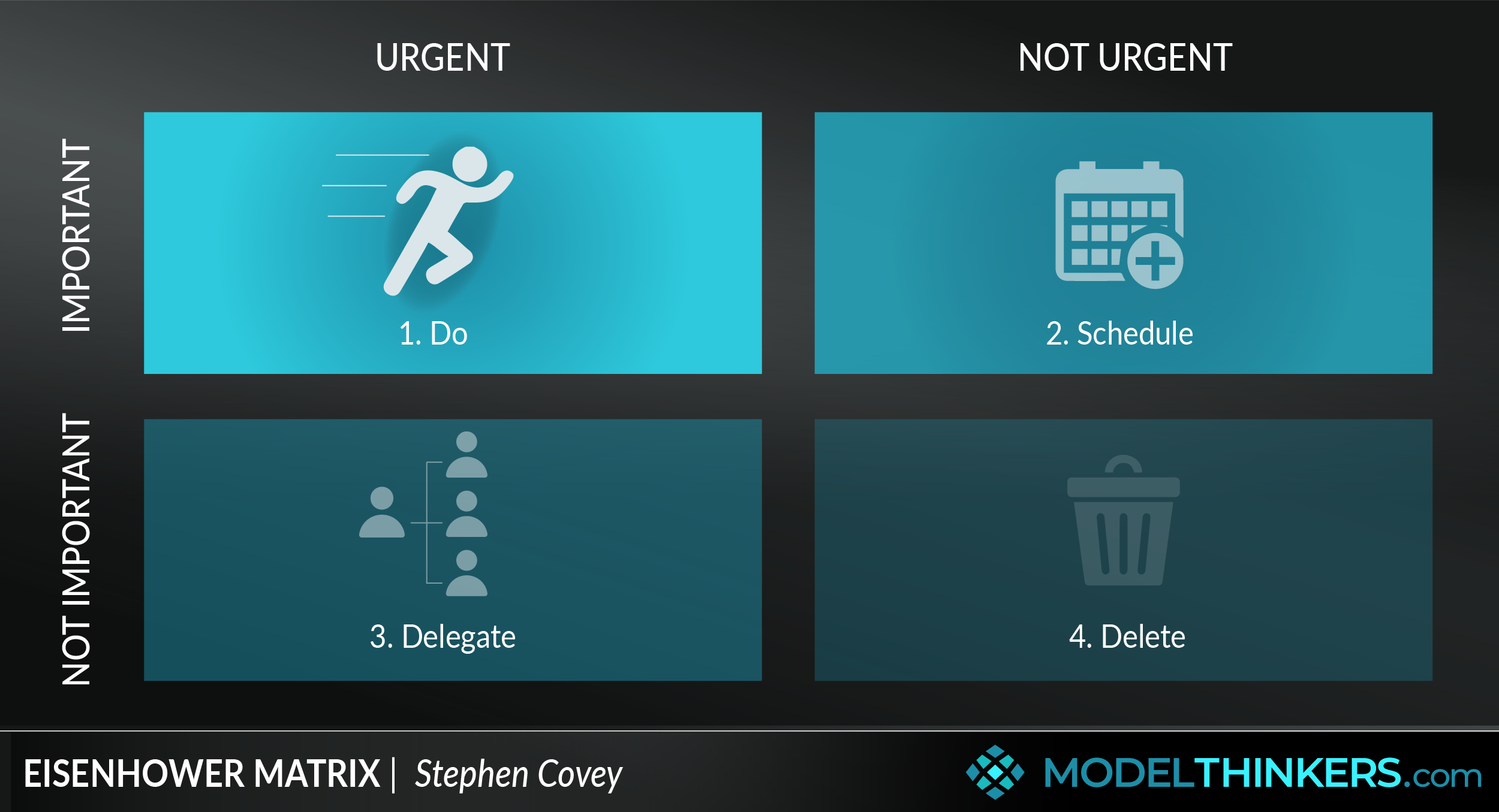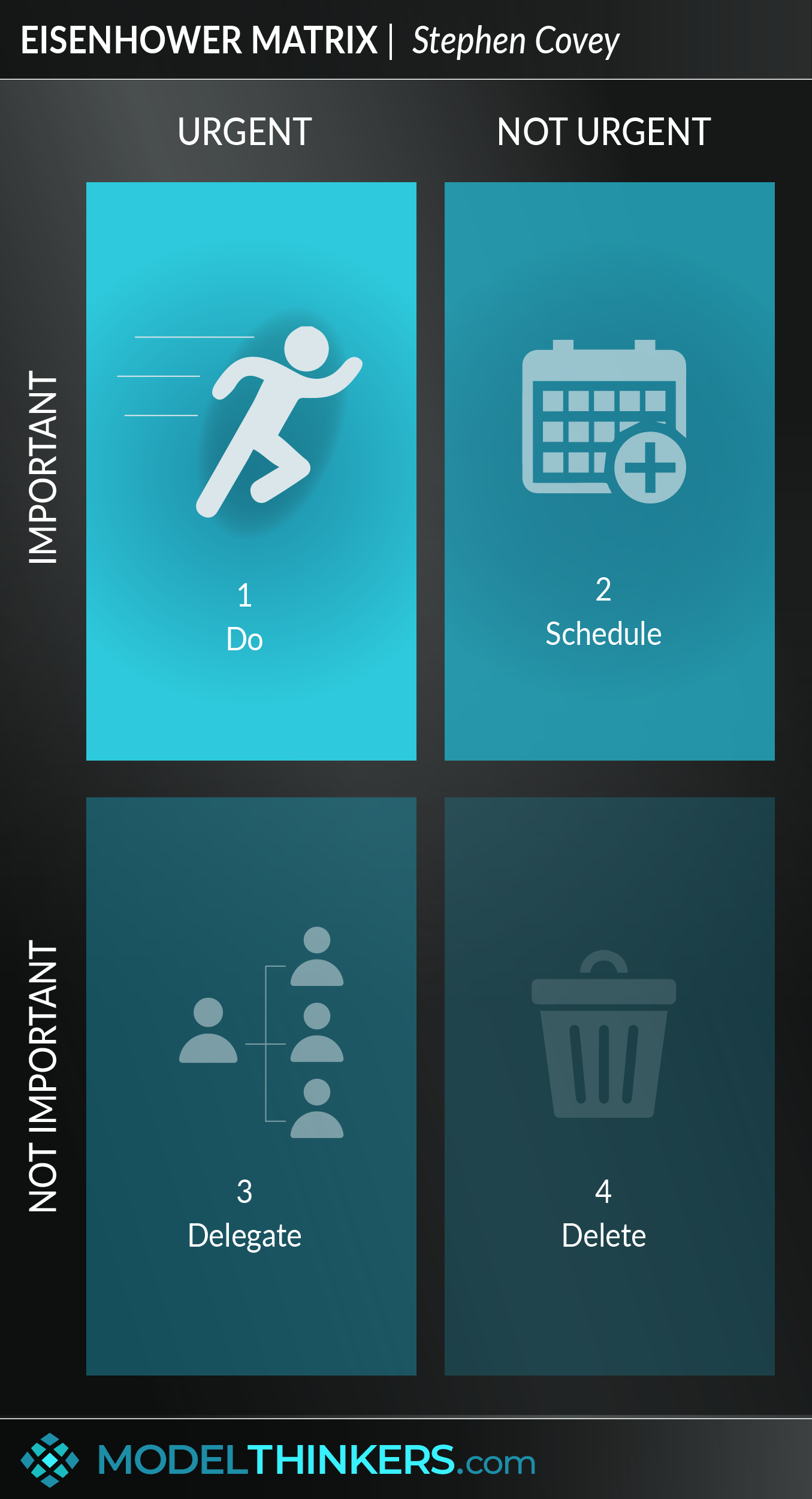

 0 saved
0 saved
 32.2K views
32.2K views








Stressed, busy and not sure what to prioritise? Stephen Covey famously said: "The key is not to prioritise what's on your schedule, but to schedule your priorities."
Stephen Covey’s Eisenhower Matrix organises your to-do list based on whether tasks are urgent or important to help you focus on high-value strategic tasks.
CLASSIFY TASKS.
The matrix is named after Dwight D.Eisenhower, who said: “I have two kinds of problems, the urgent and the important, and the important are never urgent.” It encourages you to categorise tasks based on the criteria of how urgent and important they are and then, despite Eisenhower’s quote, to prioritise important and urgent tasks.
PRIORITISE VALUE.
The aim is to get to a point where you are primarily working in the 'important and not urgent' quadrant as this reflects a more strategic approach. Applied to business it would be the equivalent of focusing your effort on tasks that work ‘on’ your business, rather than ‘in’ your business.
The matrix helps to move you out of being reactive, to focus on whether a task actually delivers the required value you are looking for. It can be used to organise your day, plan your activity for the upcoming month, and even assist teams to plan sprints or project tasks.
IN YOUR LATTICEWORK.
The Eisenhower Matrix is a productivity and time management model that works well with Kanban boards for personal use and can be implemented by teams as part of Agile Methodology.
This model has inspired the Impact Effort Matrix and, like the Circle of Concern and Influence, is one of several models popularised by Stephen Covey.




- Reflect before you react.
Before reacting to a task, take a moment to consider where it lies on the Eisenhower Matrix. It might be urgent but how important is it really? If it’s not important, consider letting it pass and focus on more high-value tasks in the top of the matrix.
- Get quadrant 1 done.
Tasks that are important and urgent demand for your attention. However, if this quadrant is always filled you should be questioning the systems and support you have in place. You’re focusing on high-value work but ultimately still in reactive mode.
- Schedule quadrant 2.
Ideally, you’ll reach a position where quadrant 1 remains relatively small and most of your time can be spent in quadrant 2. This important but not urgent work represents strategic thinking and an opportunity to be proactive in your approach.
- Delegate quadrant 3.
Urgent but not important tasks are tempting to respond to but are not a good use of your time. Consider how you might delegate them, redirect them, or simply get out of them.
- Delete quadrant 4.
Work that is not important and not urgent must obviously fall to the bottom of your priority list. Consider how you might get rid of these tasks without investing any time or resources into them.
The three limitations with this model relate more to implementation then the model itself. They include:
- Not effectively identifying what is actually ‘important’. To do this effectively requires deeper criteria or set of values/goals as criteria, otherwise, it might be relatively random.
- A disconnect between the matrix vs your reality. You might classify a task as not important and urgent and aim to avoid it, yet the reality of your work means that it is in your direct line of sight and difficult to avoid, especially if other parties are involved.
- Taking the time to continually update the matrix. Like any tool, it’s only as strong as your ability to use it and apply it.
Product management at Microsoft.
This article describes how Anusha Bahtnagar, Microsoft Product Manager, uses the Eisenhower matrix to prioritise her work. She explains: “Our gut instinct when we get an email from someone higher-up, is to drop everything we’re working on and focus solely on that. But this might not be the best thing for our prioritisation.”
The Eisenhower matrix is a productivity and time management tool.
Use the following examples of connected and complementary models to weave the Eisenhower matrix into your broader latticework of mental models. Alternatively, discover your own connections by exploring the category list above.
Connected models:
- Impact effort matrix: a related team based tool to prioritise.
- Circle of Influence and concern: another model from Covey also focused on being less reactive but from a different perspective.
- Pareto principle: in identifying the high value actions for your day or week.
- Opportunity cost: the choice of which quadrant you focus on draws out the opportunity cost of being reactive and focusing on urgent rather important activities.
Complementary models:
- Golden circle: to identify guiding values that help you choose what is actually important.
- Deep work: use this model to define tasks that would benefit from deep work - most likely those that fall into quadrant 2.
- Divide and conquer: consider how you break down tasks into subtasks to identify the important elements.
- Fast and slow thinking: pause and reflect before reacting to urgent, this includes shifting into slow thinking to categorise accurately and with less bias.
- Inversion: rather than consider a task's value, ask what would be the cost of not doing this task to consider its relative importance.
While the principles were laid out by Eisenhower, it was Stephen Covey who expressed those ideas in a simple matrix, which he described in his his seminal 7 Habits of Highly Successful People and detailed in First Things First.
Find out more about the Frankin Covey Institue here.
 My Notes
My Notes
Oops, That’s Members’ Only!
Fortunately, it only costs US$5/month to Join ModelThinkers and access everything so that you can rapidly discover, learn, and apply the world’s most powerful ideas.
ModelThinkers membership at a glance:






“Yeah, we hate pop ups too. But we wanted to let you know that, with ModelThinkers, we’re making it easier for you to adapt, innovate and create value. We hope you’ll join us and the growing community of ModelThinkers today.”


































































































